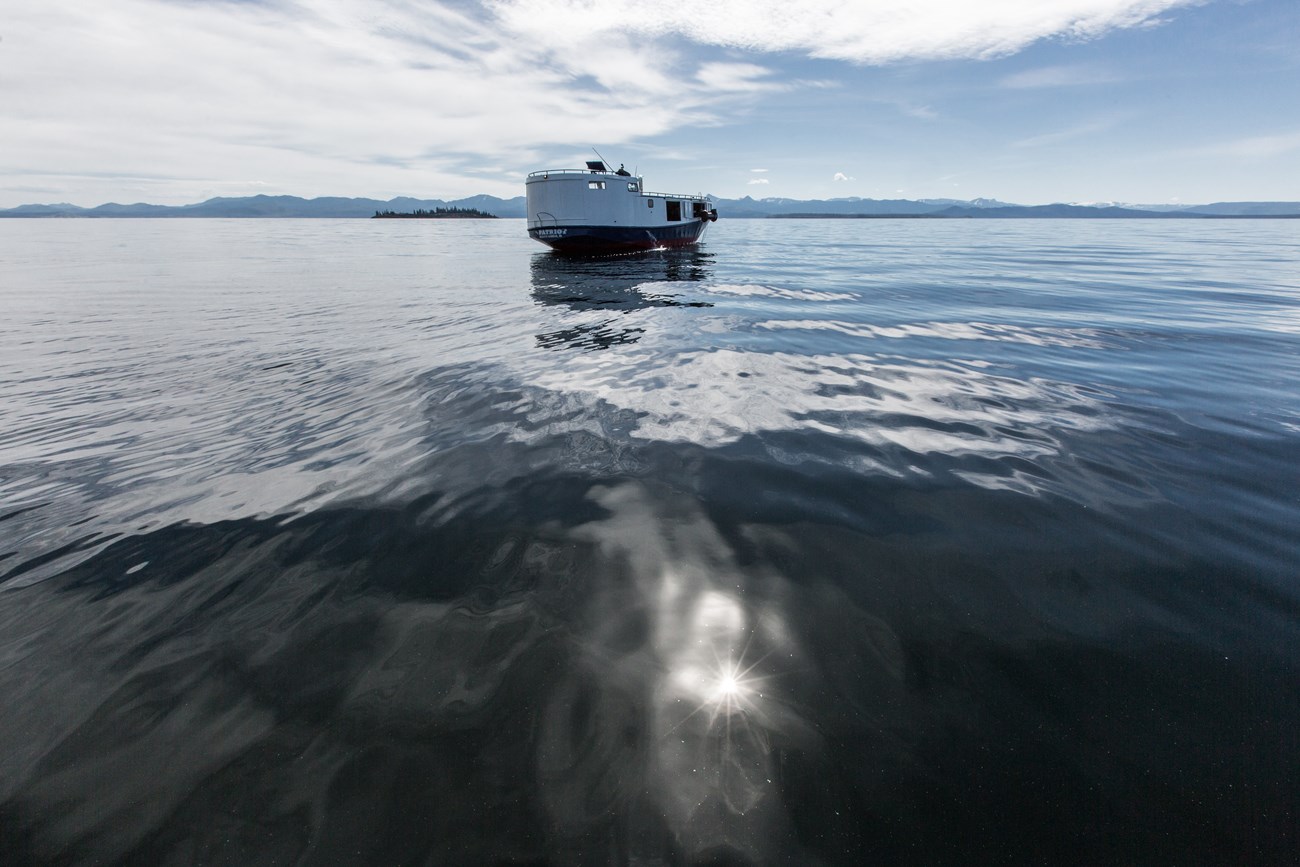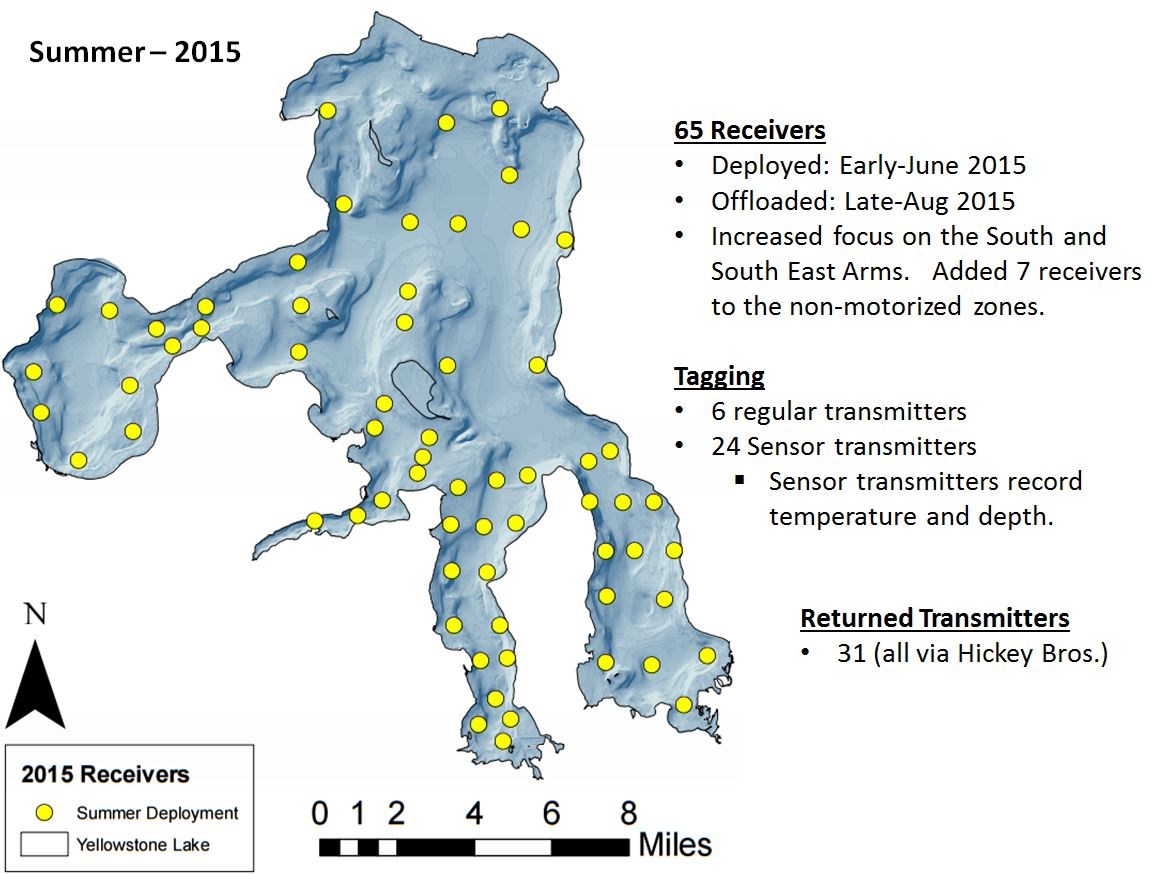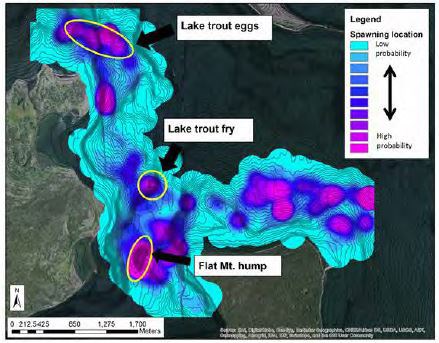All strategies to increase the efficacy of removing adult lake trout and destroying their embryos and larvae require knowledge of lake trout movement patterns, and accurate locations of spawning and embryo incubation areas. from Gresswell et al. 2017
Article
Identifying Movement Patterns and Spawning Areas of Lake Trout in Yellowstone Lake

NPS Photo - N. Herbert
by Robert E. Gresswell, Nicholas A. Heredia, Jason G. Romine, Lee F. G. Gutowsky, Philipp T. Sandstrom, Michael J. Parsley, Patricia E. Bigelow, Cory D. Suski, & Brian D. Ertel
The National Park Service has been attempting to suppress non-native lake trout in Yellowstone Lake since 1995, primarily using gillnets (Koel et al. 2005). By October 2016, approximately 2.3 million lake trout had been removed. Increased gillnetting effort accelerated the number of lake trout removed per summer, from approximately 70,000 in 2007 to approximately 366,000 in 2016. The efficiency of these netting efforts was enhanced by better understanding lake trout movement patterns and seasonal changes in those patterns.
There is growing concern it will not be possible to maintain the current levels of netting effort indefinitely. As a result, more effective and cost-efficient means of suppressing this introduced invader will be needed, even as lake trout numbers continue to decline. Alternative suppression technologies focused on the developing embryos and larvae of lake trout may have potential for supplementing a continued, but diminished gillnetting program (see “Lake Trout Suppression Alternatives to Gillnetting,” this issue). All strategies to increase the efficacy of removing adult lake trout and destroying their embryos and larvae require knowledge of lake trout movement patterns, and accurate locations of spawning and embryo incubation areas.
Although two spawning areas were identified in the West Thumb of Yellowstone Lake (Ruzycki 2004), new spawning areas have been pioneered since that time (see “Lake Trout Suppression Alternatives to Gillnetting,” this issue). Computer models suggest about 4% of the lake has sufficient habitat for supporting lake trout reproduction (Bigelow 2009). High gillnet catches in areas where lake trout congregate during the fall suggest additional spawning sites, but many of them have yet to be verified by locating lake trout embryos on the sites.
To this end, we initiated a collaborative project in 2011 to identify lake-wide movement patterns and spawning areas of invasive lake trout in Yellowstone Lake. Federal and academic scientists, with additional funding support from the Yellowstone Lake Working Group (see “Yellowstone Lake Working Group,” this issue), implanted acoustic transmitters in lake trout and established a network of stationary telemetry receivers in Yellowstone Lake. Specific research goals included: 1) locating spawning sites, 2) determining periods of greatest movement during the netting season (ice-off through mid-October), 3) locating areas where lake trout concentrate during the netting season (time within season and day versus night), and 4) determining specific travel corridors during the netting season.
Transmitters (or tags) are surgically implanted into the body cavity of the lake trout by experienced biologists. Because we were most interested in locating spawning areas, and to ensure the behavior of the individual was unaffected by tag size, we only tagged lake trout longer than 460 mm (18 in.). All transmitters are coded to emit a unique identification signal; some also have depth and temperature sensors.
Stationary receivers with an average detection radius of about 500 m (1,640 ft.) are attached to an anchored rope, with a float located at the surface visible to boaters. The number of receivers (48-65) and the position of the receivers in the lake have fluctuated annually as short-term research goals change. Field work generally begins soon after ice-off (late May-early June) with the retrieval of receivers deployed overwinter. After winter data retrieval, receivers are redeployed in a general positioning array that remains in the lake until the beginning of the spawning season in late August. Data collected during this period are focused on lake trout distribution and non-spawning movement patterns.
As the spawning season begins, the general positioning array is replaced by 1-3 fine-scale positioning arrays of 11-64 receivers each to identify specific spawning sites within the more general suspected spawning areas (figure 1). Receivers within these arrays are positioned in a grid about one km (0.6 mi.) apart. Because numerous receivers can detect an individual lake trout, it is possible to obtain two-dimensional locations for all individuals with coded transmitters and three-dimensional locations for those with depth and temperature sensors. These arrays generally operate until mid-October, when final data retrieval occurs and some receivers are retrieved. Buoys for the remaining 17-55 receivers are suspended 1.5-3 m (6-9 ft.) below the water surface to avoid encasement in the ice, where they remain submerged overwinter.

Seasonal patterns of lake trout relocations vary. Movement is generally low during the winter period (November 1-April 30) when water temperatures are low (less than 4˚C or 39˚F) and the lake is covered by ice. Most lake trout are detected deeper in the water column where temperature is higher (about 4˚C or 39˚F) than near the surface (0-1˚C or 32-34˚F).
As air temperatures increase in the spring and the ice on the lake melts, lake trout become more active. Activity remains high from ice-off until the lake begins to stratify in late June-early July; during that time individuals are often found in shallower portions of the water column.
As surface water temperatures increase in July, lake trout move to deeper, colder portions of the lake; individuals are most commonly detected at water depths where temperatures are between 7.8 and 10ºC (46ºF and 50ºF). Although lake trout still may be active, the number of receivers that detect the same individual declines, so the distances between relocations diminishes. During this period, individual lake trout make brief forays from deeper water into very shallow water, presumably to feed on native Yellowstone cutthroat trout that tend to remain in shallower water.
As day length shortens toward the middle of August, lake trout again become more active and movements become localized. We assume this is pre-spawning behavior because the number of individuals in the vicinity of known and presumed spawning areas increases. Lake trout frequent shallow water (less than 5 m or 15 ft.) at this time and are often found near the surface. This activity increases through the middle of September as water temperatures decline, though the timing of movements around suspected spawning sites can vary locally. Many lake trout move away from spawning areas by mid-October. As water temperature continues to decline, lake trout begin to move toward wintering areas, the largest of which appears to be south of Frank Island.
To identify specific spawning sites within more general spawning areas, we use statistical models to analyze individual lake trout tracks within the fine-scale receiver arrays. For example, preliminary results suggest spawning in the immediate vicinity of Carrington Island, an area where reproduction has been confirmed repeatedly. Deeper water to the southeast of the island was also identified as a probable spawning area; however, the substrate in this area consists of small gravel with no interstitial spaces and, therefore, is not ideal for spawning. Possibly lake trout are using this as a staging area prior to moving into shallower water to spawn. Analysis of data from the Snipe-Plover fine-scale array suggested several “hotspots” or sites where there was a higher density of predicted spawning behavior (figure 2); many of these coincide with verified spawning locations within the array.

Literature Cited
Bigelow, P.E. 2009. Predicting areas of lake trout spawning habitat within Yellowstone Lake. Dissertation. University of Wyoming, Laramie, Wyoming, USA.Koel, T.M., P.E. Bigelow, P.D. Doepke, B.D. Ertel, and D.L. Mahony. 2005. Nonnative lake trout result in Yellowstone cutthroat trout decline and impacts to bears and anglers. Fisheries 30:10-19.
Ruzycki, J.R. 2004. Impact of lake trout introductions on cutthroat trout of selected western lakes of the continental United States. Dissertation. Utah State University, Logan, Utah, USA.
___________________________________________________________________
Robert E. Gresswell is an emeritus research biologist with the U.S. Geological Survey’s Northern Rocky Mountain Science Center and affiliate assistant professor in the Department of Ecology at Montana State University. His current research is focused on the effects of fire, timber harvest, invasive species, and climate change on persistence of native trout. Bob has been involved with the lake trout issue in Yellowstone Lake since these invaders were first discovered in 1994 and has acted as chair of the lake trout suppression independent scientific review panel since 2008.
Part of a series of articles titled Yellowstone Science - Volume 25 Issue 1: Native Fish Conservation.
Tags
- yellowstone
- yellowstone national park
- ycr
- yellowstone center for resources
- research
- science
- fish
- yellowstone lake
- lake trout
- non-native
- yellowstone lake working group
- ys-25-1
- robert e. gresswell
- nicholas a. heredia
- jason g. romine
- lee f.g. gutowsky
- philipp t. sandstrom
- michael j. parsley
- patricia e. bigelow
- cory d. suski
- brian d. ertel
- spawning
Last updated: August 1, 2017
